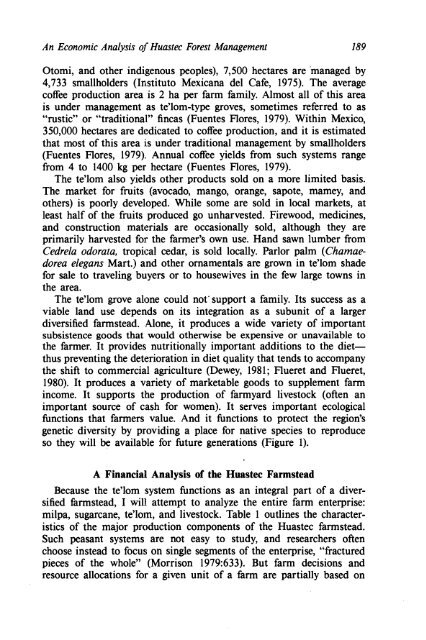Fragile Lands of Latin America Strategies for ... - PART - USAID
Fragile Lands of Latin America Strategies for ... - PART - USAID
Fragile Lands of Latin America Strategies for ... - PART - USAID
Create successful ePaper yourself
Turn your PDF publications into a flip-book with our unique Google optimized e-Paper software.
An Economic Analysis <strong>of</strong> Huastec Forest Management 189<br />
Otomi, and other indigenous peoples), 7,500 hectares are 'managed by<br />
4,733 smallholders (Instituto Mexicana del Cafe, 1975). The average<br />
c<strong>of</strong>fee production area is 2 ha per farm family. Almost all <strong>of</strong> this area<br />
is under management as te'lom-type groves, sometimes referred to as<br />
"rustic" or ''traditiona:lW fincas (Fuentes Flores, 1979). Within Mexico,<br />
350,000 hectares are dedicated to c<strong>of</strong>fee production, and it is estimated<br />
that most <strong>of</strong> this area is under traditional management by smallholders<br />
(Fuentes Flores, 1979).. Annual c<strong>of</strong>fee yields from such systems range<br />
from 4 to 1400 kg per hectare (Fuentes Flores, 1979).<br />
The te'lom also yields other products sold on a more limited basis.<br />
The market <strong>for</strong> fruits (avocado, mango, orange, sapote, mamey, and<br />
others) is poorly developed. While some are sold in local markets, at<br />
least half <strong>of</strong> the fruits produced go unharvested. Firewood, medicines,<br />
and construction materials are occasionally sold, although they are<br />
primarily harvested <strong>for</strong> the farmer's own use. Hand sawn lumber from<br />
Cedrela odorata, tropical cedar, is sold locally. Parlor palm (Chamae-<br />
dorea elegans Mart.) and other ornamentals are grown in te'lom shade<br />
<strong>for</strong> sale to traveling buyers or to housewives in the few large towns in<br />
the area.<br />
The te'lom grove alone could not'support a family. Its success as a<br />
viable land use depends on its integration as a subunit <strong>of</strong> a larger<br />
diversified farmstead. .Alone, it produces a wide variety <strong>of</strong> important<br />
subsistence goods that would otherwise be expensive or unavailable to<br />
the farmer. It provides nutritionally important additions to the diet-<br />
thus preventing the deterioration in diet quality that tends to accompany<br />
the shift to commercial agriculture (Dewey, 1981; Flueret and Flueret,<br />
1980). It produces a variety <strong>of</strong> marketable goods to supplement farm<br />
income. It supports the production <strong>of</strong> farmyard livestock (<strong>of</strong>ten an<br />
important source <strong>of</strong> cash <strong>for</strong> women). It serves important ecological<br />
functions that farmers value. And it functions to protect the region's<br />
genetic diversity by providing a place <strong>for</strong> native species to reproduce<br />
so they will be available <strong>for</strong> future generations (Figure 1).<br />
A Financial Analysis <strong>of</strong> the Huastec Farmstead<br />
Because the te'lom system functions as an integral part <strong>of</strong> a diver-<br />
sified farmstead, I will attempt to analyze the entire farm enterprise:<br />
milpa, sugarcane, te'lom, and livestock. Table 1 outlines the character-<br />
istics <strong>of</strong> the major production components <strong>of</strong> the Huastec farmstead.<br />
Such peasant systems are not easy to study, and researchers <strong>of</strong>ten<br />
choose instead to focus on single segments <strong>of</strong> the enterprise, "fractured<br />
pieces <strong>of</strong> the whole" (Morrison 1979:633). But farm decisions and<br />
resource allocations <strong>for</strong> a given unit <strong>of</strong> a farm are partially based on

















